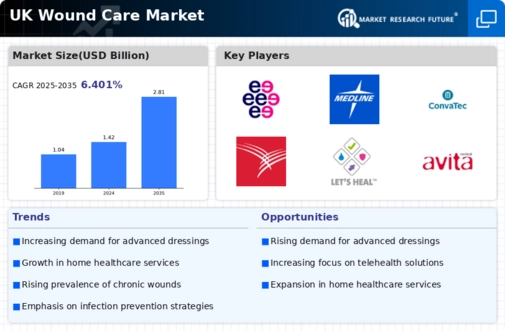Aging Population
The demographic shift towards an aging population in the UK is a critical factor influencing the wound care market. As individuals age, they are more susceptible to wounds due to factors such as reduced skin elasticity and comorbidities. By 2030, it is projected that over 18% of the UK population will be aged 65 and older, which correlates with an increased demand for wound care solutions. The wound care market is likely to see a surge in product development tailored to the needs of older adults, including specialized dressings and advanced therapies. This demographic trend underscores the necessity for healthcare providers to adapt their wound management strategies to cater to this growing segment.
Growing Awareness of Wound Care
There is a notable increase in awareness regarding the importance of proper wound care among both healthcare professionals and patients in the UK. Educational initiatives and campaigns aimed at promoting best practices in wound management are becoming more prevalent. This heightened awareness is driving demand for advanced wound care products and services within the wound care market. As patients become more informed about their treatment options, they are more likely to seek out specialized care, thereby increasing the market's growth potential. Furthermore, healthcare providers are increasingly prioritizing wound care training, which enhances the overall quality of care delivered.
Increased Healthcare Expenditure
The rise in healthcare expenditure in the UK is a significant driver for the wound care market. The UK government has committed to increasing funding for healthcare services, which includes wound management. In recent years, healthcare spending has risen by approximately 4% annually, reflecting a growing recognition of the importance of effective wound care. This investment enables the wound care market to innovate and expand its product offerings, ensuring that healthcare providers have access to the latest technologies and treatments. Enhanced funding also facilitates better training for healthcare professionals, ultimately leading to improved patient care and outcomes.
Rising Incidence of Chronic Wounds
The increasing prevalence of chronic wounds, such as diabetic ulcers and pressure sores, is a notable driver in the wound care market. In the UK, it is estimated that chronic wounds affect approximately 1-2% of the population, leading to a substantial demand for advanced wound care products. The wound care market is responding to this need by developing innovative solutions that enhance healing and improve patient outcomes. The financial burden associated with chronic wounds is significant, with treatment costs reaching up to £3 billion annually in the UK. This growing incidence necessitates a robust supply of effective wound care products, thereby propelling market growth.
Technological Innovations in Wound Management
Technological advancements in wound management are transforming the wound care market. Innovations such as bioengineered skin substitutes, smart dressings, and telemedicine solutions are emerging as key components of modern wound care strategies. The wound care market is witnessing a shift towards more effective and efficient treatment options, which can significantly reduce healing times and improve patient outcomes. For instance, smart dressings equipped with sensors can monitor wound conditions in real-time, allowing for timely interventions. This trend not only enhances the quality of care but also aligns with the increasing demand for personalized medicine in the UK healthcare landscape.




















Leave a Comment